by Mie
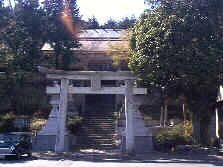
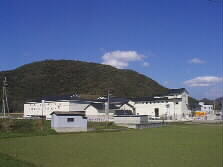

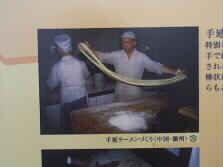
The panel (left) illustrates the history
of Soumen: Around 7,000 B.C., wheat had
been cultivated in Mesopotamia area and around
1,000 B.C. , the invention of rotary mortar
triggered the spread of wheat plantation
in wider area such as Egypt, Central Asia.
Wheat, together with rotary mortar, was brought
to China around 300 B.C. through the Silk
Road.
Old Chinese then produced "Mizuhiki-mochi", a kind of rice cake-presumably the root of Soumen-, from wheat. The rice cake technology was brought to Japan through the Japanese envoys to Tang Dynasty China.
Wheat civilization has spread all around the world, but what is interesting is, noodle civilization has developed in Italy and Asian countries. A Chinese makes lamian from a lump of dough added with oil on the surface (right.)
Old Chinese then produced "Mizuhiki-mochi", a kind of rice cake-presumably the root of Soumen-, from wheat. The rice cake technology was brought to Japan through the Japanese envoys to Tang Dynasty China.
Wheat civilization has spread all around the world, but what is interesting is, noodle civilization has developed in Italy and Asian countries. A Chinese makes lamian from a lump of dough added with oil on the surface (right.)
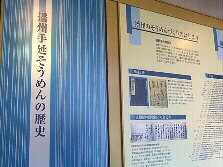
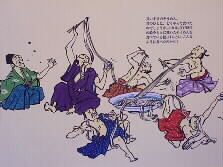

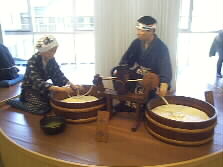
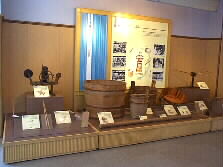
Mannequins demonstrate how to make Soumen
in a traditional way: the mannequin on the
left coats (Saimoku-process, left) the surface
of still thick Soumen with cotton oil so
as to protect them from drying before making
Soumen thinner by a hand-driven tools like
this (right.)
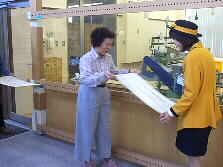
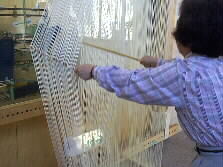
Even today, when the production process is
largely mechanized, there are still many
handwork steps that causes the name of the
final product as "Hand-made Soumen."
Visitors can experience the "pulling"
process: the dough in the length of about
ten centimeters will be very carefully stretched
up to about two meters without severing them.
Dividing the stretched Soumen requires the
skill as well. The chewy dough made me perspired
in just one time trial.
Making Soumen starts four in a cold winter morning by kneading the flour. It takes about 36 hours to undergo the final inspection after five times maturing. Only intensified care can produce high quality hand-made Soumen under the brand name of "Ibo-no-Ito."
Making Soumen starts four in a cold winter morning by kneading the flour. It takes about 36 hours to undergo the final inspection after five times maturing. Only intensified care can produce high quality hand-made Soumen under the brand name of "Ibo-no-Ito."
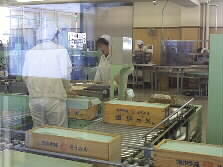
The Soumen of this area has won the nationwide reputation. This is because the manufactures were organized in early days (1865) into a union in order to keep and improve the quality of the "Ibo-no-Ito" brand.
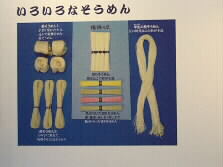
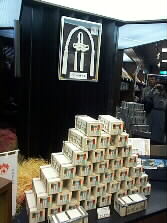
There are many types of product (left.)
In
the center top is standard Soumen,
other
variations included are longer size,
colored
ones, and others. Somen is also for
sale
in a shop (right.) The small boxes
are called
"Hine", meaning matured over
a
year. On the top is a monumental Soumen
ornament
called Yokozuna (of Sumo wrestling.)
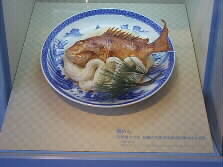
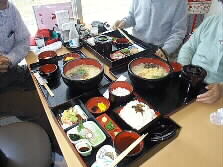
In the front is a tray of cold Soumen, and two large bowls contain hot Soumen. As this area is famous for its production of "thin" soy sauce, we can enjoy very tasty Soumen with rich flavor of the soy sauce. I have been very familiar with Soumen since my childhood, but I have learned much more today.
Soumen Museum: 56-Okumura Kamioka town Tatsuno City, Hyougo prefecture Japan; Phone 0791-65-9000